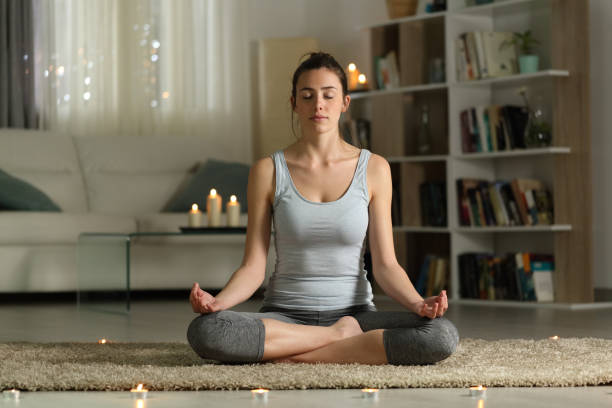In today’s fast-paced world, sleep can often feel elusive. Between work stress, constant connectivity, and the whirlwind of daily life, many people find it difficult to unwind and fall into a peaceful slumber. This is where meditation can make a profound difference. In this article, we’ll explore the most effective meditation techniques for better sleep. Whether you struggle with falling asleep, staying asleep, or just want to improve the quality of your rest, these practices will help you unwind and prepare for a more rejuvenating night of sleep.
Why Meditation is Effective for Better Sleep?
Before diving into specific techniques, it’s important to understand why meditation can be such a powerful tool for improving sleep:
Reduces Stress and Anxiety:
Meditation activates the parasympathetic nervous system (the “rest and digest” system), which counters the fight-or-flight response triggered by stress and anxiety. This helps calm the mind and prepare the body for rest.
Promotes Mindfulness and Presence:
Many people struggle to sleep because their minds are racing with worries, thoughts, and distractions. Meditation trains you to focus on the present moment, reducing rumination and allowing you to let go of anxious thoughts.
Regulates Breathing:
Slow, deep breathing during meditation helps activate the body’s relaxation response. This can lower heart rate and blood pressure, signaling to your body that it’s time to rest.
Improves Sleep Cycle:
Regular meditation has been shown to improve the quality of sleep over time by helping you relax before bed and promoting deeper, more restorative sleep stages.
Top Meditation Techniques for Better Sleep:
Meditation is not only beneficial for reducing stress and increasing mindfulness but is also one of the most effective natural remedies for improving sleep quality. By calming the mind and body, meditation techniques can help you ease into a restful sleep.
1. Mindfulness Meditation:
Mindfulness meditation involves focusing on the present moment without judgment. This practice allows you to acknowledge any thoughts or feelings that arise and then gently bring your focus back to the present.
By practicing mindfulness before bed, you can clear your mind of stress and racing thoughts. This will help you release the mental clutter that often prevents you from falling asleep. This is one of the best meditation techniques for better sleep.
How to Practice Mindfulness Meditation for Sleep:
-
Find a Comfortable Position: Lie down in bed or sit comfortably in a chair.
-
Focus on Your Breath: Take a few deep breaths to settle into the present moment. Pay attention to the sensation of air entering and leaving your lungs.
-
Let Go of Any Distractions: As thoughts come and go, simply observe them without attachment and gently return your focus to your breath.
-
Notice Your Body: Bring awareness to the sensations in your body. Notice where you feel tension or discomfort, and consciously relax those areas.
2. Body Scan Meditation:
Body scan meditation is a form of mindfulness where you mentally “scan” your body from head to toe, paying attention to each part of the body and noticing any tension or discomfort.
This meditation technique helps release physical tension, which is often a significant barrier to falling asleep. By bringing awareness to each body part, you can relax muscle groups, which induces a feeling of calm. This is one of the best meditation techniques for better sleep.
How to Practice Body Scan Meditation for Sleep:
-
Lie Down Comfortably: Settle into a lying position in your bed, closing your eyes.
-
Start at Your Toes: Slowly bring your attention to your toes. Notice any sensations, warmth, or tension. Allow any tension to melt away as you breathe deeply.
-
Move Up Through Your Body: Gradually shift your focus up your body—ankles, calves, knees, thighs, abdomen, chest, arms, neck, and head—pausing to notice sensations and relax each area.
-
Breathe Deeply: As you move through the body, take slow, deep breaths, releasing tension with each exhale. By the time you reach your head, you should feel deeply relaxed.
3. Guided Sleep Meditation:
Guided meditation for sleep typically involves listening to a meditation teacher or a recording that leads you through a series of relaxing visualizations or affirmations designed to induce a sense of peace and calm.
For beginners or those who struggle with focusing on their own, guided meditations provide a structured and soothing voice to help ease you into sleep. This can be particularly helpful if you tend to feel restless or distracted. This is one of the best meditation techniques for better sleep.
How to Practice Guided Sleep Meditation:
-
Choose a Sleep Meditation Recording: Find a guided sleep meditation that suits your preferences—whether it’s a relaxation story, a gentle body scan, or a calming visualization.
-
Get Comfortable: Lie down and make sure you are in a relaxed position. Ensure your environment is dark and quiet.
-
Listen and follow the Guidance: As the guide leads you through the meditation, focus entirely on their voice. Let the instructions direct your attention away from any worries or stress, allowing your body to relax.
-
Let Go: Allow the guided meditation to lull you into sleep naturally. If you do wake up during the night, try to re-focus on the voice or the visualization to return to sleep.
4. Breathing Techniques:
Breathing exercises focus on regulating your breath to induce a state of calm. One popular technique is the 4-7-8 method, which involves inhaling, holding, and exhaling in a specific pattern.
Slower, deeper breaths signal to your brain that it’s time to relax. This helps lower heart rate and blood pressure, preparing your body for sleep. This is one of the best meditation techniques for better sleep.
How to Practice the 4-7-8 Breathing Technique for Sleep:
-
Sit or Lie Down Comfortably: Get into a relaxed position with your eyes closed.
-
Inhale Through Your Nose for 4 Seconds: Breathe in slowly and deeply through your nose.
-
Hold the Breath for 7 Seconds: Keep the air in your lungs, feeling the relaxation deepen.
-
Exhale Through Your Mouth for 8 Seconds: Exhale slowly and steadily, making a soft whooshing sound.
-
Repeat the Cycle: Continue for 4-5 cycles. The extended exhalation helps activate the parasympathetic nervous system, calming the body and preparing it for rest.
5. Loving-Kindness Meditation (Metta):
Loving-kindness meditation, or Metta, involves silently repeating phrases of goodwill and compassion, first towards yourself, then towards others. It fosters a sense of peace and positive emotions, which can create a more relaxed mindset for sleep.
Cultivating positive emotions such as love and kindness helps to alleviate stress and anxiety, which can be significant barriers to a good night’s sleep. This is one of the best meditation techniques for better sleep.
How to Practice Loving-Kindness Meditation for Sleep:
-
Find a Quiet Space: Sit or lie in a comfortable position.
-
Repeat Loving Phrases to Yourself: Silently repeat phrases such as, “May I be happy, may I be at ease, may I be peaceful.”
-
Extend the Wishes to Others: Gradually extend these wishes to loved ones, acquaintances, and even those with whom you may have conflicts. You might say, “May [name] be happy, may [name] be at ease.”
-
Feel the Warmth: As you repeat these phrases, try to feel a warm sense of compassion and love growing within you, which will help you relax and prepare for sleep.
Additional Tips for Enhancing Sleep with Meditation:
-
Consistency Is Key: Practice meditation nightly. The more consistently you meditate, the more effective it will be in promoting better sleep.
-
Create a Sleep-Friendly Environment: Make sure your bedroom is cool, dark, and quiet. Limit distractions like electronic devices before bed.
-
Keep It Relaxing: The goal is to relax, not to force yourself into sleep. If you’re struggling, don’t stress—simply focus on deep breathing or gentle body scans to help you wind down.
Conclusion:
Meditation is a simple yet powerful tool for enhancing sleep quality. Whether through mindfulness, body scan, guided meditation, breathing techniques, or loving-kindness practices, each method can help calm the mind, reduce stress, and prepare your body for a restful night of sleep. By integrating these techniques into your nightly routine, you can improve the quality of your sleep, wake up feeling refreshed, and experience a more peaceful state of mind throughout the day.





